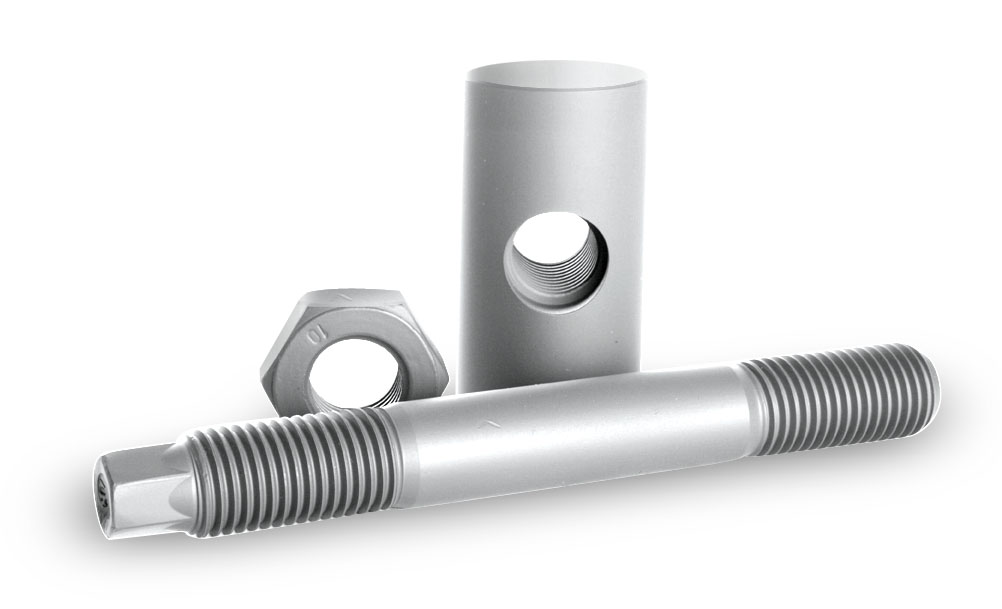Dörken MKS-Systeme has made a coating system newly certified by Germanischer Lloyd for use in wind energy plants the focal point of its presentation at the HUSUM WindEnergy 2012. / High-strength fastening elements, e.g. for securing rotor blades, consequently receive multifunctional protection through micro-layer coating. / Defined surface slide and friction characteristics ensure excellent connectability, including for pre-assembly processes.
Following over 15 years of experience in the field and the approval of numerous leading wind energy manufacturers worldwide, in August 2012 Germanischer Lloyd has now granted the system structure of basecoat Delta®-Tone and topcoat Delta®-Seal certification for use on standard bolts for wind energy plants in the onshore and offshore fields. The high-strength fastening elements coated with this system, in particular those in the dimension range M24 to M48, have already been successfully employed in gondolas and rotor blade fastening for many years. Dörken MKS-Systeme GmbH & Co. KG, Herdecke, has placed the certified coating system in the centre of its presentation at the HUSUM WindEnergy 2012. The certified coating system was the focus of the presentation of Dörken MKS-Systeme GmbH & Co. KG at the HUSUM WindEnergy 2012. Here the company welcomed numerous trade visitors from Germany and abroad, including many representatives of the fastener industry. One highlight was the meeting with NRW environment minister Johannes Remmel, who was impressed with the innovative energy of the Herdecke-based company. The state of North Rhine-Westphalia was represented at the fair by 150 companies. The state thereby had by far the most stands amongst the approximately 1,200 German and international exhibitors, presenting itself as the core state of the German subcontracting industry for wind energy.
Certification by Germanischer Lloyd was accomplished via the presentation of the necessary measurement findings recorded by the Institut für Lackprüfung Andreas Keiner GmbH, Wettenberg, and the company Schatz AG, Remscheid, on the basis of corresponding accreditation. For example, the average coat thickness of the entire structure was measured at approximately 30 µm, using various measurement methods. The corrosion durability of the test bolts was tested for a minimum of 1,500 hours in salt spray testing in accordance with DIN EN ISO 9227. The coefficient of friction was also tested on a reference part from series coating under various conditions. The system of basecoat and topcoat with integrated lubricant demonstrated consistent overall coefficients of friction µtot in a window between 0.08 and 0.14. Adjustability in tight spreads – for example via lubricants – is possible.
For increased requirements
The Delta®-Tone basecoat offers active cathodic protection, thereby fulfilling the increased requirements of wind energy plants in offshore operation. Application of the coating is via spin coating or spraying for larger fastening elements, such as bolts for the securing of rotor blades. As no hydrogen is involved in the coating process, the risk of hydrogen embrittlement of the high-strength component as a result of the coating procedure can be safely excluded. In the subsequent stage the coating is cured at 180 – 220 °C for 30 – 60 minutes. The organic topcoat in the form of Delta®-Seal serves to further increase corrosion protection. However, the main advantage of this topcoat for use with wind energy plants is that slide and friction properties are satisfied, with the consequence that optimal connectability is provided in all assembly processes. Additional benefits with topcoating include the fulfilment of requirements such as colour, temperature and UV resistance or resistance to chemicals.
The alternative to conventional systems
The system is now in use worldwide with almost all well-known manufacturers of wind energy plants, as it offers a safe and economical alternative to the conventional surface protection systems often used in wind energy plants. The low curing temperature means that it is also highly energy efficient and damage to the high-strength steel components caused by excessively high temperatures can be avoided. The low coat thickness means that it is sometimes possible to avoid the cost-intensive repeat cutting of the nut threads, enabling full-surface corrosion protection to also be achieved in the area of the thread. High-performance corrosion protection for high-strength fastening elements makes a key contribution to largely enabling freedom from maintenance for the entire plant – particularly in safety-relevant areas.

NRW environment minister Johannes Remmel (left) visited the stand of Dörken MKS-Systeme at the HUSUM WindEnergy 2012, where he was warmly welcomed by Managing Director Dr. Martin Welp.

With the Germanischer Lloyd-certified system structure comprising the basecoat Delta®-Tone and topcoat Delta®-Seal high-strength fastening elements such as this M48 screw for rotor blade securing acquire multi-functional protection in the field of multi-layer coating for wind energy plants.

To receive the certificate by the Germanischer Lloyd, different test results had to be presented. Therefore a coated bolt was literally “taken apart”.
Photo: Dörken MKS-Systeme GmbH & Co. KG
Information about the company
Dörken has been developing micro layer corrosion protection systems in Herdecke for over 30 years. Under the DELTA-MKS® brand name the company produces and configures extremely high-performance surface protection, for use in the automobile and wind energy industries in particular. The globally specified products are free from heavy metals such as chromium(VI). More information regarding this can be obtained at www.doerken-mks.com
